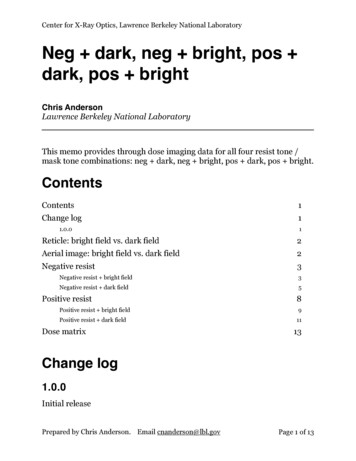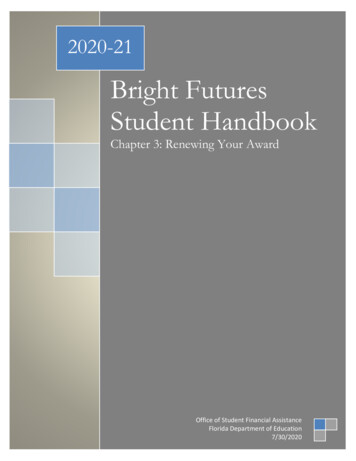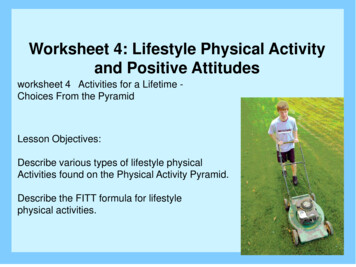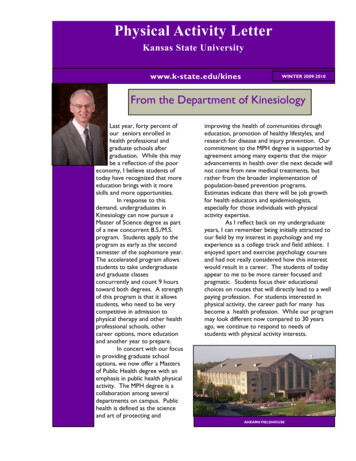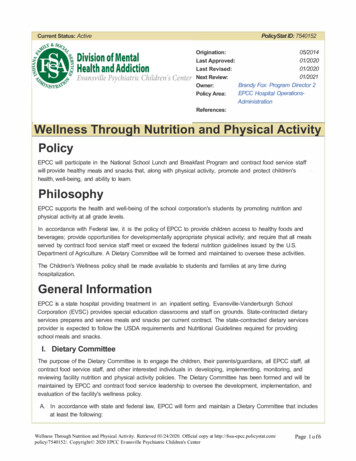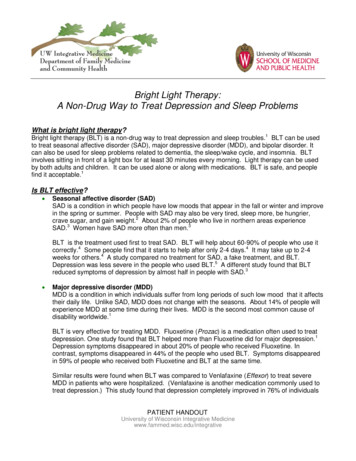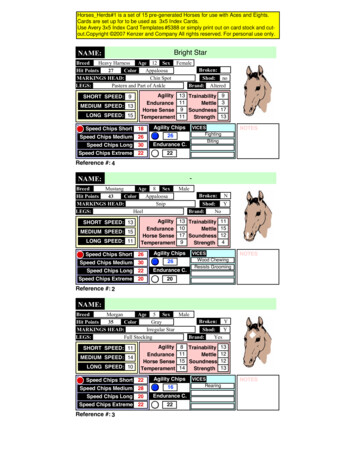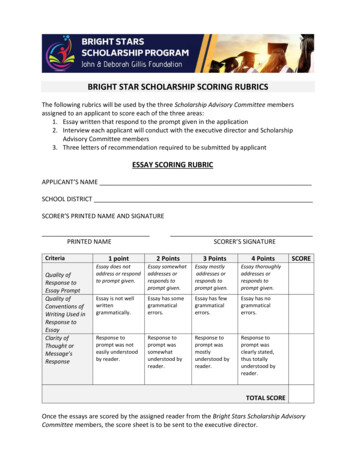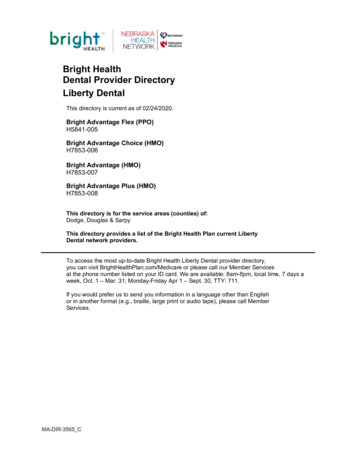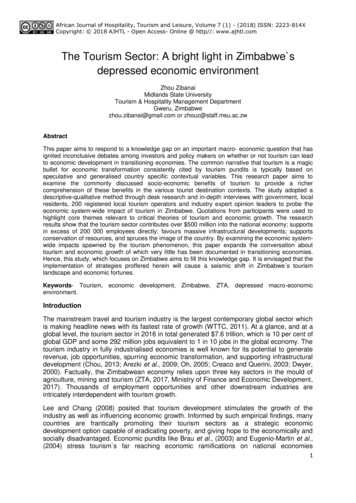
Transcription
Physical ActivityTools
Anaerobic. Intense physical activity that is short induration and requires a breakdown of energysources in the absence of sufficient oxygen. EnergyPhysical ActivityThe term “physical activity” describes manyforms of movement, including activities thatinvolve the large skeletal muscles.1,2 Activities thatsources are replenished as an individual recoversfrom the activity. Anaerobic activity (e.g., sprintingduring running, swimming, or biking) requiresmaximal performance during a brief period.involve the small skeletal muscles (e.g., playingboard games, drawing, writing) are important, butthey do not provide the health benefits of activitiesthat involve the large skeletal muscles and requiresubstantial energy expenditure.Physical activity is defined by its duration,intensity, and frequency:Lifestyle. Physical activity typically performed on aroutine basis (e.g., walking, climbing stairs, mowingor raking the yard), which is usually light to moderate in intensity.Physical activity play. Play activity that requires substantial energy expenditure (e.g., playing tag, jumping rope). Duration is the amount of time spent participating in a physical activity session. Intensity is the rate of energy expenditure. Frequency is the number ofphysical activity sessionsduring a specific time period (e.g., 1 week).Types of PhysicalActivityAerobic. Light- to vigorousintensity physical activitythat requires more oxygenthan sedentary behavior andthus promotes cardiovascularfitness and other health benefits (e.g., jumping rope, biking, swimming, running;playing soccer, basketball, orvolleyball).179TOOL ATOOL A: DEFINITIONS OF PHYSICAL ACTIVITY,EXERCISE, AND FITNESS
TOOL APlay. Activity with flexible rules, usually self-selected, for the purpose of having fun.Sports. Physical activity that involves competition,scorekeeping, rules, and an outcome that cannot bepredetermined. Sports are usually divided into several categories, such as individual (e.g., gymnastics),dual (e.g., tennis), and team (e.g., basketball).Weight-bearing. Physical activity that requires peopleto move their own weight. Weight-bearing activity(e.g., jumping rope, walking, gymnastics, playingvolleyball) contributes to the growth of healthybones in children and adolescents.ExerciseExercise consists of activities that are plannedand structured, and that maintain or improve oneor more of the components of physical fitness.1“Physical activity” and “exercise” are often usedinterchangeably. However, “physical activity” suggests a wide variety of activities that promote healthand well-being, whereas “exercise” is often associated with fitness maintenance or improvement only.To achieve specific fitness and performance goals,people must focus on the duration, intensity, andfrequency of exercise sessions.ing an arm upward while standing and leaning tothe opposite side). Specific flexibility exercises needto be done for each part of the body.Isokinetic. Muscle-fitness exercise in which the speedof movement is usually controlled, allowing maximal force to be exerted throughout the full range ofmovement.Types of ExerciseIsometric. Muscle-fitness exercise in which theamount of force equals the amount of resistance, sothat no movement occurs (e.g., pushing against adoor frame while standing in a doorway).Calisthenics. Isotonic muscle-fitness exercise thatoverloads muscles (e.g., pushups, side leg raises,abdominal curl-ups) by forcing the muscles to workat a higher level than usual.Isotonic. Muscle-fitness exercise (e.g., weightlifting)in which the amount of force exerted is constantthroughout the range of motion, including muscleshortening (concentric contractions) and musclelengthening (eccentric contractions).Flexibility (stretching). Exercise designed to stretchmuscles and tendons to increase joint flexibility orrange of motion (e.g., trying to touch the floor withthe hands while the legs are nearly straight, stretch-180
References1.Caspersen CJ, Powell KE, Christensen GM. 1985.Physical activity, exercise, and physical fitness: Definitions and distinctions for health-related research.Public Health Reports 100(2):126–131.2.Centers for Disease Control and Prevention, NationalCenter for Chronic Disease Prevention and HealthPromotion; President’s Council on Physical Fitnessand Sports. 1996. Physical Activity and Health: AReport of the Surgeon General. Washington, DC: Centers for Disease Control and Prevention, NationalCenter for Chronic Disease Prevention and HealthPromotion; President’s Council on Physical Fitnessand Sports.3.Pellegrini AD, Smith PK. 1998. Physical activity play:The nature and function of a neglected aspect of playing. Child Development 69(3):577–598.4.Franks BD, Howley ET. 1998. Fitness Leader’s Handbook (2nd ed.). Champaign, IL: Human Kinetics.5.Anschel MH, Freedson P, Hamill J, Haywood K, Horvat M, Plowman SA. 1991. Dictionary of the Sport andExercise Sciences. Champaign, IL: Human Kinetics.6.Corbin CB, Lindsey R, Welk G, Corbin W, Welk K.2000. Concepts of Physical Fitness: Active Lifestyles forWellness (10th ed.). Dubuque, IA: McGraw-Hill Higher Education.FitnessParticipating in physical activity is beneficial topeople of all ages. Physical activity contributes to fitness, a state in which people’s health characteristicsand behaviors enhance the quality of their lives.4Types of FitnessPhysical fitness. A set of physical attributes related toa person’s ability to perform physical activity successfully, without undue strain and with a marginof safety.1Health-related physical fitness. A physiological stateof well-being that reduces the risk of hypokineticdisease (i.e., disease resulting from abnormallydecreased mobility or abnormally decreased motorfunction or activity); a basis for participation insports; and a vigor for the tasks of daily living.5Components include cardiorespiratory endurance,muscle strength and endurance, flexibility, andbody composition.Suggested ReadingBouchard C, Shepard RJ, Stephens T, eds. 1994. PhysicalActivity, Fitness, and Health: International Proceedingsand Consensus Statement. Champaign, IL: HumanKinetics.Skill-related physical fitness. Common components ofphysical fitness (e.g., agility, balance, coordination,speed, power, reaction time) that enable participation in sports and other physical activities; alsocalled performance or motor fitness.6Pate RR, Pratt M, Blair SN, Haskell WL, Macera CA, et al.1995. Physical activity and public health: A recommendation from the Centers for Disease Control andPrevention and the American College of Sports Medicine. Journal of the American Medical Association273(5):402–407.181TOOL AMuscle-fitness. Exercise designed to build musclestrength and endurance by overloading the muscles; also called progressive resistance exercise (PRE).Common forms of muscle fitness exercise includeisokinetic, isometric, and isotonic. Specific exercisesneed to be done for each major muscle group.
TOOL BTOOL B: HELPING CHILDREN AND ADOLESCENTSIMPROVE PHYSICAL ACTIVITY BEHAVIORSAvariety of factors motivate children andadolescents to participate in physicalactivity, including guidance and encouragement from health professionals.1 ToThe counseling suggestions presented here arebased on several models of behavior change. One ofthese models, the stages of change (shown below),illustrates the steps people go through when theyare considering making a change.5–8Although there is considerable research validating this model’s applicability to adults, more limited research exists for its applicability to childrenless than 9 years of age. Thus, health professionalsare encouraged to consider this model as only ageneral framework for health behavior change forchildren.promote physical activity in children and adolescents,health professionals need to consider factors (e.g., personal, social, environmental) that affect children’s andadolescents’ participation. Health professionals alsoneed to consider children’s and adolescents’ readiness to change, because it affects the steps that children, adolescents, and their families need to take toimprove or maintain their levels of physical activity.1. PrecontemplationFactors Affecting PhysicalActivity LevelsDescription: Is unaware of problem and hasn’tthought about change. Has no intention of taking action within the next 6 months.The following factors affect children’s and adolescents’ physical activity levels:2–42. ContemplationDescription: Intends to take action within thenext 6 months. Self-efficacy Expectation of positive outcomes from physicalactivity3. Preparation Barriers that make it difficult to participate inphysical activityDescription: Intends to take action within thenext 30 days and has taken some behavioral stepsin this direction. Enjoyment of physical activity4. ActionPhysical activity counseling can help childrenand adolescents do the following:Description: Has changed overt behavior for lessthan 6 months. Increase self-efficacy Understand the benefits of being physicallyactive5. MaintenanceDescription: Has changed overt behavior for morethan 6 months. Reduce barriers to physical activity Select enjoyable activities182
Stage 1: PrecontemplationGoal: Encourage the child or adolescent to participate in physical activity.1. Identify the benefits of physical activity.Rationale: Children and adolescents may not beaware of the benefits of physical activity (e.g.,promotes well-being; helps reduce the risk of certain diseases such as coronary heart disease,hypertension, colon cancer, diabetes mellitus).Counseling statement: “Elena, being physicallyactive is one of the most important things youcan do to stay healthy, both physically and mentally. It can also help you build strong bones andfeel energetic.”2. Explain the benefits of physical activity as theypertain to the child or adolescent.CounselingThe health professional begins physical activitycounseling by assessing the child’s or adolescent’sself-efficacy, knowledge of the benefits of physicalactivity, perceived barriers to participation in physical activity, and stage of change. The health professional needs to consider these factors, along withthe medical history and physical examinationresults, and family and community resources.One example that demonstrates how healthprofessionals have successfully used these factors toassess and counsel adults is the Patient-CenteredAssessment and Counseling for Exercise (PACE) program.9–11 Preliminary research on the program’sefficacy with adolescents ages 11 to 17 showspromising results. PACE researchers expect the program to be efficacious for children and adolescentsof other ages. The following physical activity counseling approaches, which have been adapted fromPACE research, describe how to counsel childrenand adolescents at different stages of change.Rationale: Children and adolescents may understand that physical activity is good for them, butthis may not be enough to convince them tobecome physically active. The health professionalneeds to personalize the benefits of physicalactivity and the risks of inactivity based on thechild’s, adolescent’s, and family’s health history.Counseling statement: “Charlie, participating inphysical activities, such as walking, might helpreduce your risk of developing diabetes, whichyour older sister has. I know that you’re concerned about this, and this is a way for you to dosomething about it.”3. Recommend that the child or adolescent consider beginning some type of physical activity.Rationale: One study found that a physician’srecommendation to exercise would be taken veryseriously by more than 75 percent of high schoolstudents.12 So health professionals can influence183TOOL BChildren and adolescents and their familiesmay be at any of these stages in terms of their decision to increase or maintain their physical activitylevels. Physical activity counseling is most helpfulwhen it is tailored to the child’s or adolescent’sstage of change. For example, for children and adolescents at the precontemplation stage, explainingthe benefits of physical activity is more useful thantalking about specific activities. Children and adolescents at the contemplation and preparationstages need counseling to help them set realisticgoals, make plans for change, and reduce barriers.Children and adolescents at the action and maintenance stages benefit from counseling on how toprevent a relapse.8
TOOL Bchildren’s and adolescents’attitudes toward physicalactivity.Counseling statement: “Lauren,your weight is above the recommended weight range foryour age and height. If youwere to begin something assimple as brisk walking for 30minutes each day, you’d probably feel a lot better and lose theextra weight.”Stages 2 and 3: Contemplationand PreparationGoal: Help the child or adolescent develop a plan for participating in physical activity.1. Help the child or adolescent identify the benefitsof physical activity.pate in ones they enjoy. The health professionalneeds to provide guidance on the duration,intensity, and frequency of activities.Rationale: Children and adolescents are more likely to participate in physical activity if theybelieve they will receive something in return. Thehealth professional needs to help children andadolescents identify what they will gain bybecoming physically active.Counseling statement: “Beth, what types of physical activities do you enjoy? Are there any youhave enjoyed in the past? If so, which ones? Howmuch activity do you think you can handle rightnow?”Counseling statement: “Hilary, why are you interested in becoming physically active now? Whatdo you hope to gain by participating in physicalactivity?”3. Help the child or adolescent identify barriers tophysical activity.Rationale: Children and adolescents may face barriers that prevent them from participating inphysical activity. Identifying these barriers is thefirst step to overcoming them.2. Help the child or adolescent choose appropriatephysical activiti
Physical Activity Tools. 179 TOOL A TOOL A: DEFINITIONS OF PHYSICAL ACTIVITY, EXERCISE, AND FITNESS Physical Activity The term “physical activity” describes many forms of movement, including activities that involve the large skeletal muscles.1,2 Activities that involve the small skeletal muscles (e.g., playing board games, drawing, writing) are important, but they do not provide the health .
